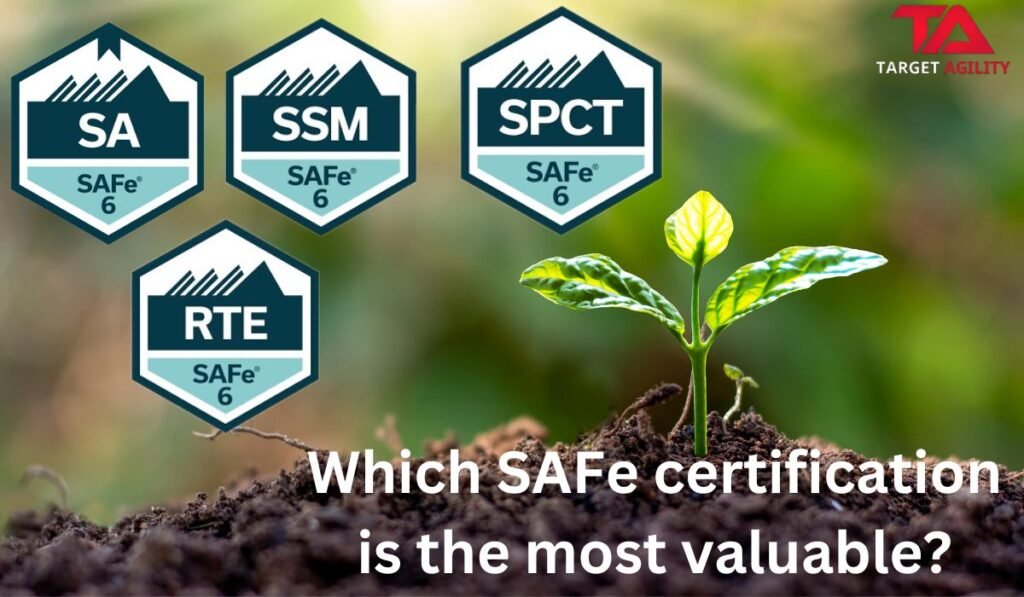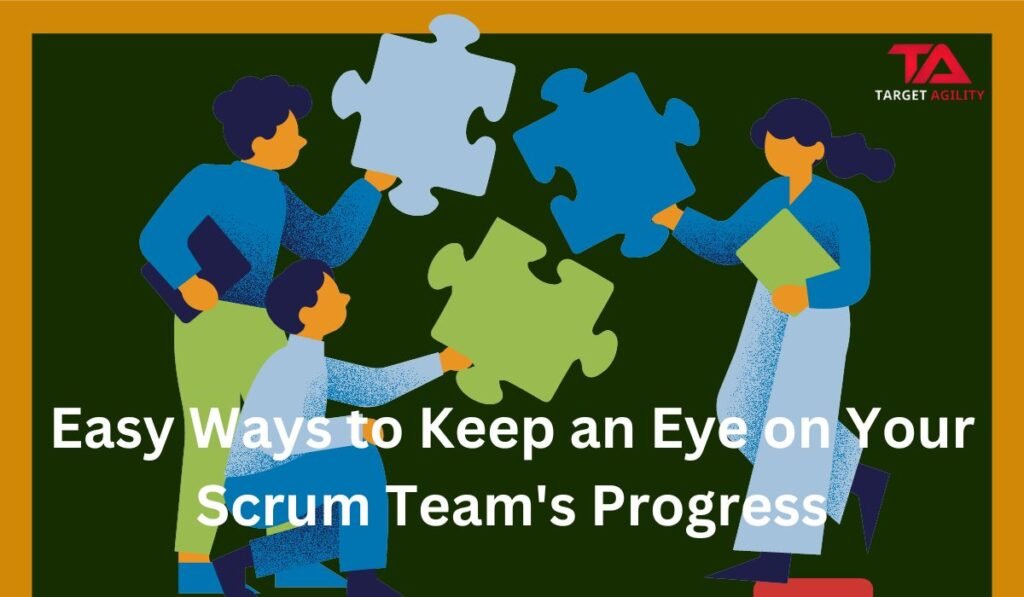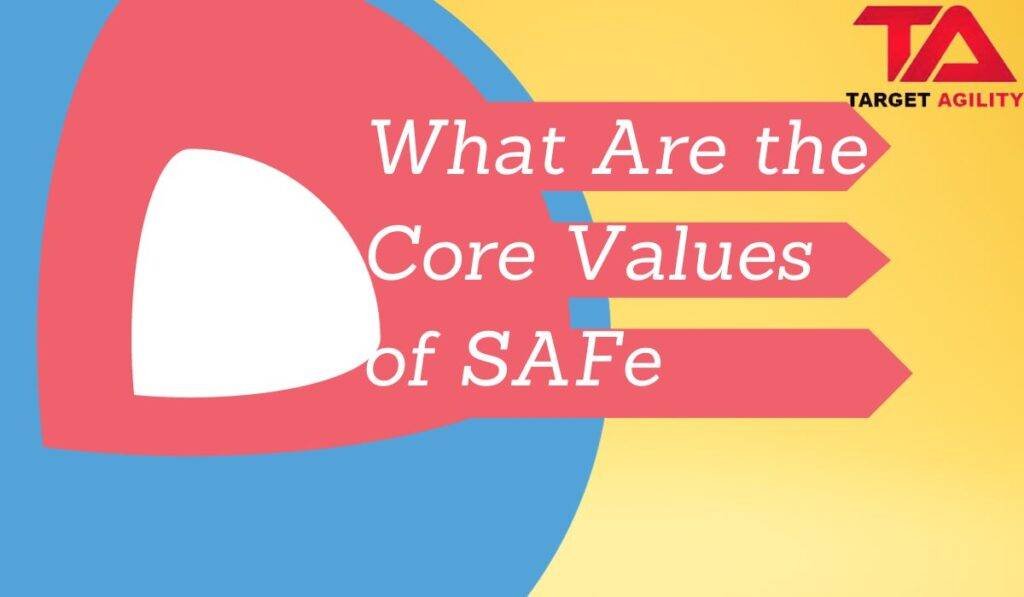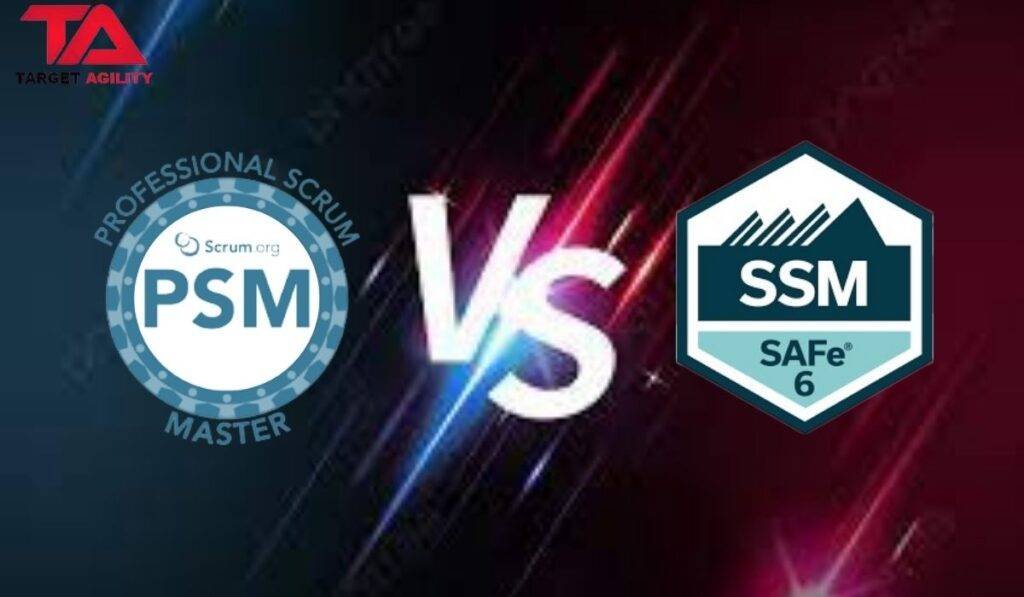Which SAFe certification is the most valuable?

SAFe certification, is a way of doing agile and lean practices on a large scale in organizations. It’s super popular, and a lot of people want to be certified in it. There are different SAFe certifications for different jobs or levels of experience. The one that’s most valuable for you depends on what you want to do in your career. SAFe Agilist (SA) This is the basic certification. It’s good if you’re new to SAFe or just want to get a general idea of how it works. In the course, you learn about SAFe values, principles, roles, and how to put SAFe into action. SAFe Scrum Master (SSM) If you’re a Scrum Master working in a SAFe environment, this certification is for you. It teaches you how to do Scrum in a SAFe way, coach Scrum teams, and make Scrum work for big organizations. SAFe Advanced Scrum Master (SASM) This one is for Scrum Masters who really know their stuff and want to be SAFe experts. You learn how to solve problems with Scrum, use Kanban and engineering practices, and help big groups of teams. SAFe Release Train Engineer (RTE) Release Train Engineers plan and do SAFe Release Trains. This certification teaches you how to plan and run them, handle dependencies, and make them work well. SAFe Program Consultant (SPC) If you’re a consultant helping companies use SAFe, this certification is for you. It covers how to figure out if a company is ready for SAFe, make a plan for it, train and coach teams, and keep track of how well it’s going. To choose the right one for you, think about your job and how much you know about SAFe. Here’s a quick guide: Hope this helps you figure out which SAFe certification is right for you!
Boosting Your Career: Unleashing Opportunities with PSM, SAFe, and PSPO Certifications

In today’s dynamic and competitive professional landscape, continuous learning and skill development are paramount for career advancement. Earning certifications in high-demand areas like project management and Agile methodologies can significantly enhance your employability and open doors to new opportunities. Among the most sought-after certifications are PSM (Professional Scrum Master), SAFe (Scaled Agile Framework), and PSPO (Professional Scrum Product Owner) credentials. These certifications demonstrate your expertise in leading and managing successful Agile projects and can help you achieve your career goals. The Significance of PSM, SAFe, and PSPO Certifications PSM, SAFe, and PSPO certifications are globally recognized and valued by employers across industries. They validate your proficiency in Scrum, the Agile framework that has revolutionized software development and project management. By earning these certifications, you can: PSM Certification: Mastering Scrum Mastery The PSM certification is the gold standard for Scrum Masters, recognizing their expertise in facilitating and leading successful Scrum projects. It validates your ability to: SAFe Certification: Navigating the Scaled Agile Landscape The SAFe certification demonstrates your proficiency in the Scaled Agile Framework (SAFe), a comprehensive framework for scaling Agile methodologies across large organizations. It validates your ability to: PSPO Certification: Empowering Product Owners The PSPO certification validates your expertise as a product owner, the role responsible for defining, managing, and prioritizing product backlog items. It demonstrates your ability to: Unleashing the Power of Certifications Earning PSM, SAFe, and PSPO certifications can transform your career trajectory. These certifications not only enhance your marketability and earning potential but also empower you to lead and manage complex projects effectively. By investing in professional development and pursuing these industry-recognized credentials, you can position yourself for success in the ever-evolving world of project management and Agile methodologies.
Easy Ways to Keep an Eye on Your Scrum Team’s Progress

In the world of software development, Scrum teams work together to get things done. To make sure your Scrum team is doing well, it’s important to measure and track their progress. In this blog, we’ll explore simple ways to do that without getting too complicated. Defining Success: Figuring Out What Matters Before we start, let’s think about what success means for your team. Look for signs like how much work gets done in a sprint or if the team is facing any challenges. These signs are called key performance indicators (KPIs), and they help you see if you’re on the right track. Burndown Charts: Watching Work Disappear Imagine a chart that shows how much work is left in a sprint. That’s a burndown chart. A good burndown chart goes down steadily, showing progress. If it goes all over the place, it might mean there are problems or changes happening. Sprint Burnup Charts: Keeping an Eye on Workload Sprint burnup charts help you see if the team is finishing what they planned for a sprint. It’s like checking if you’re on track with your to-do list. If everything is going smoothly, the chart looks balanced. If there are sudden increases, it could mean unexpected work or changes in plans. Velocity: Checking How Fast You’re Going Velocity is a fancy word that means how much work your team can do in a sprint. Keep an eye on it over time. If it stays about the same, your team is doing well. Big changes might mean something is going wrong or the team is adjusting to new things. Cycle Time: Counting the Days Cycle time is how long it takes to finish a task from start to finish. Short cycle times are good—it means things are moving quickly. If it takes a long time, there might be problems that need fixing. Escaped Defects: Checking for Mistakes Nobody likes mistakes. Escaped defects are like problems that sneak through and are found later. Try to have as few of these as possible by doing thorough testing and fixing issues before they become big problems. Team Satisfaction: Keeping Everyone Happy Beyond all the numbers, it’s important to make sure your team is happy. Ask them how they feel and if they’re facing any challenges. A happy team works better and produces better results. Adapt and Iterate: Changing Course When Needed Remember, it’s okay to change things if they’re not working. Keep checking if your measurements make sense, and if they don’t, find new ones. Being flexible and always trying to improve is the key to success. Conclusion: Sailing Smoothly Measuring your Scrum team’s progress is like navigating a ship. By using simple tools like burndown charts, velocity, and keeping the team happy, you can steer your ship in the right direction. The journey might have some ups and downs, but with a flexible and positive approach, your Scrum team can sail smoothly to success.
Boosting Your Career and Business: 5 Reasons to Take a SAFe Course

In today’s fast-paced business world, being flexible and quick is crucial. Companies that can adapt, innovate, and deliver value rapidly have a big advantage. That’s where the Scaled Agile Framework (SAFe) comes in. Many organizations are using SAFe and encouraging their employees to take SAFe courses. In this blog, we’ll explain five strong reasons why you should think about doing the same. 1. Stand Out in a Competitive Job Market The job market is changing, and employers are looking for people who know SAFe principles and practices. Taking a SAFe course gives you the knowledge and skills you need to succeed in agile organizations. It can also make your resume more appealing, whether you want to move up in your current job or explore new opportunities. 2. Lead Changes with Confidence One of the best things about SAFe is that it’s adaptable to different industries, not just software development. By enrolling in a SAFe course, you’ll understand the framework well and be ready to lead changes in various types of organizations. SAFe helps you make things more efficient, improve quality, and make customers happier. 3. Boost Your Team’s Productivity Agile is all about delivering value to customers quickly and efficiently. SAFe provides a set of principles and practices to help with this. By taking a SAFe course, you’ll learn how to make your processes work better, reduce obstacles, and increase your team’s productivity. This can lead to better products, faster deliveries, and happier customers. 4. Improve Collaboration and Communication SAFe puts a lot of focus on working together, communicating well, and being transparent in your organization. Taking a SAFe course can improve your ability to work smoothly with teams from different departments, engage with stakeholders effectively, and create a culture of ongoing improvement. These skills are valuable for project managers, product owners, Scrum Masters, and anyone involved in the Agile process. 5. Achieve Long-Term Growth SAFe is designed to help organizations succeed in the long run. With a SAFe course, you’ll learn how to develop growth strategies that focus on customers and are sustainable over time. This framework encourages innovation, adaptability, and a customer-centered approach, ensuring your organization remains competitive in a constantly changing business world. In summary, taking a SAFe course can be a game-changer for your career and your organization. It equips you with the knowledge and skills to navigate the complex world of Agile business, lead transformation, and achieve great results. So, whether you’re a professional looking to advance in your career or an organization aiming for more agility, SAFe courses hold the key to unlocking your full potential. Ready to start your SAFe journey? Explore our SAFe certification courses and take the first step toward unlocking business agility today. Your future self and your organization will thank you for it.
SAFe Core Values Made Easy: The Building Blocks of Agile Success

In a fast-paced world, businesses want to stay competitive and make customers happy. To do that, they turn to Agile principles and frameworks like the Scaled Agile Framework (SAFe). SAFe has become popular for helping big organizations be more Agile. At the heart of SAFe are its core values, which are like the rules that make it work. In this blog, we’re going to dive into these core values of SAFe and see why they are so important for companies that want to change and succeed in today’s tough business world. 1.Working Together The first core value of SAFe is all about making sure that everyone in the company is going in the same direction. It’s like having a team huddle where everyone knows what the goal is. In SAFe, this is done through things like setting a common goal and planning big work cycles. This helps all teams and people in the company work together toward the same mission. 2.Quality Matters The second core value, “Quality Matters,” is all about making sure the work is good from the start. It’s like building a strong and reliable car that doesn’t break down. In SAFe, we use things like testing early and putting the work together often to make sure it’s high quality. This helps avoid mistakes and makes the product or service better. 3.Sharing Is Caring The third core value, “Sharing Is Caring,” is about being open and honest with everyone in the company. It’s like having a super clear glass window, not a foggy one. In SAFe, we use things like sharing progress and problems openly. This creates a culture where people can talk to each other easily and ask for help when needed. 4.Getting the Work Done The fourth core value, “Getting the Work Done,” is about being effective and efficient when doing the work. It’s like a well-organized sports team that scores goals quickly. In SAFe, we use tools and ceremonies like planning and teamwork to make sure the work gets done well and on time. 5.Think Agile The fifth and most important core value is called “Think Agile.” It’s about changing the way you and your company think about work. It’s like shifting from old-fashioned ways to modern, flexible ways. In SAFe, we encourage teams and leaders to think in an Agile way, which means being open to change, focusing on customers, and always improving. Why the Core Values Matter Understanding these core values is super important for companies trying to be more Agile. Here’s why they matter: Conclusion SAFe’s core values are the building blocks that make the framework work. They are the foundation for changing and succeeding in today’s business world. By focusing on working together, making quality a priority, being open, getting work done well, and thinking in an Agile way, companies can use SAFe to its fullest and succeed in a world that keeps changing. These core values are the secret sauce to making SAFe work for your company.
PSM vs. SSM: Understanding Scrum Masters in Different Settings

Scrum is a popular way to manage complex projects. The role of a Scrum Master is crucial in making sure things go smoothly. But Scrum Masters can have different jobs depending on the setting. Let’s explore the differences between a Professional Scrum Master (PSM) and a Scaled Scrum Master (SSM) and what skills are needed for each. Professional Scrum Master (PSM) PSM is a certification for Scrum Masters who work with one Scrum Team. They help the team follow the Scrum rules and improve. Here are some key things about PSM: Scaled Scrum Master (SSM) On the other hand, Scaled Scrum Masters deal with multiple Scrum Teams and a more complex environment. They make sure these teams work together well and reach common goals. Here are some key things about SSM: Key Differences Key Similarities Skills Needed To be a good PSM or SSM, you need certain skills: Professional Scrum Master (PSM): Scaled Scrum Master (SSM): Conclusion In short, Professional Scrum Masters (PSMs) and Scaled Scrum Masters (SSMs) have different roles in Scrum and Agile. PSMs focus on one team and the basics of Scrum, while SSMs work with many teams in a more complex setting. The choice between the two depends on what an organization needs, but both need good leadership, teaching, and problem-solving skills. Whether you’re a PSM or an SSM, the goal is the same: making things better and delivering value to customers through Agile ways of working.

